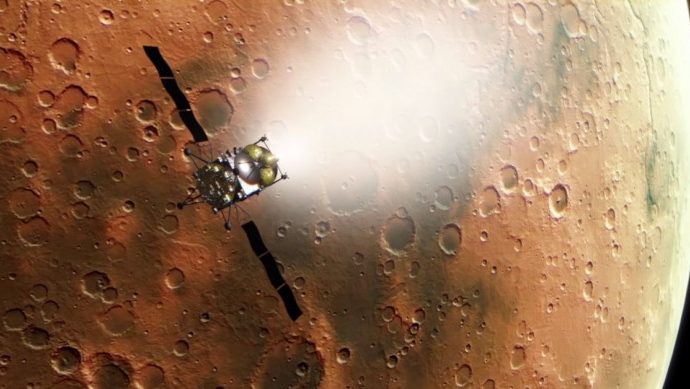Other attempts by the Soviet Union and Russia have failed, but Japan could be the first to land on Mars’ moon, Phobos.
Source: Interesting Engineering
Japan is moving forward with plans to land a spacecraft on Phobos, a moon of Mars, according to a recent announcement. If it works, this mission will make Japan the first in the history to successfully touchdown on the surface of the Martian moon, and possibly the first round-trip mission to the Mars system.
Japan’s mission to touchdown on Mars’ moon
JAXA, Japan’s space agency, announced that the Martian Moons Exploration (MMX) project has officially progressed into the development phase. The team will start producing the hardware and developing software for the mission ahead of its planned 2024 launch.
If this schedule holds, the MMX will arrive in the Martian system sometime in 2025. Once there the craft will spend three years surveying both of Mars’ moons: Phobos and Deimos, to map their surfaces in intricate detail.
While this is happening, MMX will make a touchdown on Phobos to take a sample, digging at least 2 centimeters (0.78 inches) into the surface. The team behind the spacecraft also plans to send a rover along to hop around on Phobos’ surface, much like the one released on an asteroid in 2018 [link?].
The spacecraft will be equipped with 11 instruments tasked with measurement-taking assignments throughout the entire mission. If nothing goes wrong, the mission will return to Earth with samples from Phobos by 2029.
Phobos as a stepping stone to Mars
It’s tempting to see Phobos as a bizarre choice for such a serious mission, but the small moon is intriguing to planetary scientists. We still don’t know if Phobos and Deimos are asteroids captured by Mars’ gravitational pull, or if they were born from a violent impact with Mars, sometime in its deep past.
This mission could potentially answer those questions.
Many are also considering Phobos as a stepping stone for future human missions to Mars. “Humans can realistically explore the surfaces of only a few objects and Phobos and Deimos are on that list,” said Jim Green, NASA chief scientist, in the JAXA statement. “Their position orbiting about Mars may make them a prime target for humans to visit first before reaching the surface of the Red Planet, but that will only be possible after the results of the MMX mission have been completed.”
As for NASA itself, the U.S. space agency will contribute two instruments to the MMX mission: one to analyze elements on Phobos’ moon, and a “pneumatic sampling device.” NASA researchers have actively discussed missions to Phobos for years, including ones with humans. A 2007 workshop paper argued that crewed missions to the Martian moons “will help get and keep the Humans to Mars ball rolling earlier than otherwise possible.”
And the truth is, MMX could.
But there is embarrassing precedence for worry. In 1988, the Soviet spacecraft Phobos 2 was sent to the moon with a rover and lander slated for a touchdown. Unfortunately, the spacecraft’s computer malfunctioned just before it was scheduled to dispatch explorer robots, and the mission was considered a failure. The last time an attempt was made to land anything on Phobos didn’t go better: the Russian Phobos-Grunt mission — launched in 2011 — didn’t even escape Earth orbit. Instead, it fell back into the Pacific in 2012.
So while Japan’s first foray to Phobos’ surface is not without precedent, it couldn’t hurt for space enthusiasts to cross their fingers in the coming years, for a safe touchdown and return from Mars.
Source: Interesting Engineering

































Leave a Comment
You must be logged in to post a comment.